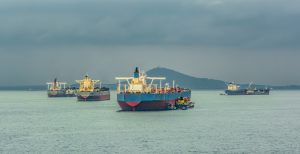“An accident waiting to happen,” tweeted a senior analyst at Lloyd’s List Intelligence. Michelle Wiese Bockmann had spotted a cluster of 43 oil tankers jostling in international waters off the coast of Malaysia last November. The advanced age of the vessels (20 years on average), as well as their amorphous owners and unknown insurance status, were all cause for concern. The tanker traffic jam, she concluded, was a maritime safety hazard in one of the busiest international shipping lanes.
The proliferation of VLCCs (Very Large Crude Carriers) near Johor was an early indicator of a major shift in global oil flows. In December 2022, Europe stopped importing Russian oil and petroleum products. Crude prices were capped at $60 a barrel as part of the sanctions package. Two months later, G-7 nations imposed another price cap on premium products like diesel. With Europe officially off-limits, Russian oil flooded into the Asian market.
Energy industry experts were bracing for impact. “If the price cap is imposed, economic theory will collide with the messy reality of the market,” predicted Ben Cahill, a senior fellow at the Center for Strategic and International Studies in Washington, D.C.
The price cap led to a noticeable uptick in activity by the “dark fleet,” industry shorthand for oil carriers that use deceptive shipping practices such as hiding their location, frequently changing flags, or obscuring their ownership structure. These vessels risk losing insurance coverage if their sanctions evasion activities come to light. According to Windward, Singapore is among the top three ports of origin for dark fleet ships.
The international waters off the coast of Malaysia have been a hub of dark fleet activity for more than a decade. Tankers ferrying oil from sanctioned nations like Iran and Venezuela have routinely converged in the area to carry out ship-to-ship transfers of crude. The cargo is stored in VLCCs for blending and is sold under brand names like Mal Blend or Singma, masking the product’s country of origin. Small, independent refiners in China, known as “teapots,” are the primary market for the low-cost blends.
Russia’s entry into the club of sanctioned nations turbocharged the tanker business. In October 2022, Aframax-class vessels were in high demand, and several “old, creaking ships that might have otherwise ended up in the scrapyard” changed hands, according to a CNN report. Tankers carrying sanctioned Venezuelan crude shifted gears to exploit the lucrative trade in price-capped Russian oil.
In late 2022, Malaysia exported nearly 800,000 barrels of crude to China daily, double the amount of oil that the country produced. The record volume of crude exports raised a few eyebrows. “I don’t think that’s Malaysian crude. So, there’s plenty of stuff moving around outside these … theoretical caps,” oil analyst Paul Sankey told CNBC’s “Street Signs Asia.”
Tankers that make the trip to Southeast Asia typically pass through other international “dark” oil hubs along the way. According to a report by Windward, one Malaysia-bound vessel was “spoofing” or manipulating satellite location data off the west coast of Africa in December. The unnamed vessel transmitted for six straight days from the exact same coordinates, unusual for a ship at sea. The Mid-North Atlantic is a known hotspot for ship-to-ship transfers of Russian oil. After the spoofing activity, the tanker rounded the Cape of Good Hope and sailed towards Tanjung Bruas, a strategically located port in the Strait of Malacca. The report concluded that the vessel’s suspicious behavior exposed insurers to “financial and reputational risk.”
In May, an Aframax tanker called Pablo burst into flames off the coast of Malaysia in the same spot that Lloyd’s List Intelligence had identified as a maritime hazard zone. The blast ripped off the deck “like a sardine can.” Three crew members were missing, and four others onboard were seriously injured. The 26-year-old vessel had a history of ferrying sanctioned Iranian oil to China and had last offloaded cargo at Qingdao. The explosion occurred as the ship was heading toward Singapore, reportedly for a transfer from a crude carrier.
Who is responsible for the wreck of Pablo? Since the ownership and insurance status of the tanker is murky, Malaysian authorities are left holding the bag. For now, the partially charred vessel remains anchored off the coast of Johor.

































